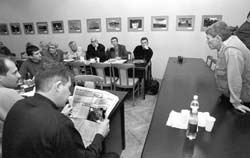Photojournalists Breakthrough

It is hardly necessary to explain how important a role photography plays in the print media. After all, whether the readers will direct their favorable gaze on this paper frequently depends on how the first page looks; and depending on how successfully illustrated the newspaper is as a whole largely determines whether they will buy it again. Yet The Day, for instance, has long since come to the conclusion that photography is not simply the decoration of a newspaper page, but quite a self sufficient and very important journalistic genre.
Last week in Kyiv a two-day seminar on Contemporary Newspaper Photography took place, organized for photojournalists of the regional media by the National Union of Ukrainian Journalists. According to the main organizer of this event Liudmyla Olkhovska, photojournalists from the union assembled for the first time in fifteen years. And so talk ranged from modern equipment and the problem of organizing a work place for photojournalists to issues of safeguarding copyrights in the field of photography. But the main interest of the regional photojournalists (who came from Dnipropetrovsk, Donetsk, Zhytomyr, Poltava, and other regions) was due to a studio experience including photojournalists of The Day, Mykola Lazarenko and Anatoly Medzyk, who divulged secrets of their professionalism. And the interest was not only provoked by the standard of design to which the editorial staff of our publication devote rapt attention, but also the reputation already set by The Day’s trademark photo competitions, in which photojournalists from the regions not only take part, but also win. In particular the appearance of Mykola Lazarenko was devoted to the experience of organizing photo competitions and holding photo exhibitions from their results. But no less interesting for our colleagues turned out to be recipes from the editorial kitchen of The Day. How to build relations of a photograph with journalists and an editor; how is photography planned; what are the features of work with politicians or representatives of the armed forces. These are only a few from the considered themes. And the discussion itself continued even while being mentioned in the seminar plan for lunch.
The realization that newspaper photographic artists are the same as journalists, but ‘without the right to make a mistake’ (after all unlike their colleagues of the quill they cannot edit already prepared material: here, published or not published), is only starting to develop in Ukraine. Therefore it is doubly gratifying that the proper role of photojournalist’s work is being carried out not only in The Day.






